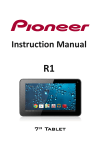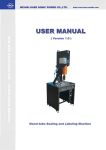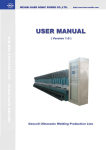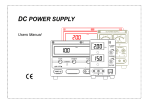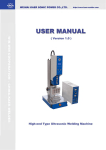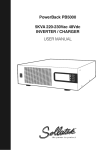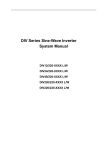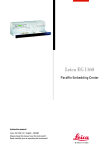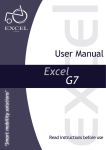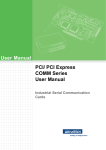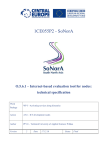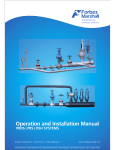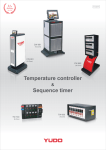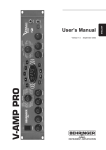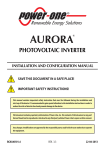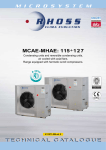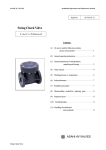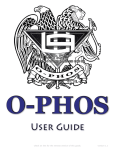Download Kaer Ultrasonic for Superior Service
Transcript
Kaer Ultrasonic for Superior Service Thank you for your recognition and welcome to the use of “Kaer Ultrasonic” power ultrasonic equipment. We are making our earnest commitment to guarantee your investment results, we Before-sales service Our free technical assistance is available to you from now on: 1. Recommend equipment of top choice based on your requirements for product; 2. Examining mold drawings on your behalf to confirm optimum structure size meeting ultrasonic process; 3. Providing assistance in manufacturing and modifying tools; 4. Sample for welding. During-sales Service 1. 2. 3. 4. Punctual deliver of equipment as per Contract; Free door to door service for installation and debugging; Professional training for operators; Our engineering instruction will guarantee your productive manufacturing of top-quality products. After-sales service 1. Available within 24hours within Shandong Province and 48hours beyond the province; 2. Our regular return visits ensure continuous improvement of our service quality. Our cooperation starting from today, and Our friendship extending from here! I. General Information Ultrasonic plastic welder is mainly used for secondary joining of thermoplastics. Compared with other traditional processes (such as gluing, electric heat-joining, or screw tightening), it has remarkable advantages like high productivity, sound welding quality, environmental protection and energy saving, among others. Working principle of ultrasonic plastic welder: the welder converts the electric energy into ultrasonic energy through the ultrasonic transducer (i.e. high-frequency mechanical vibration energy with the frequency exceeding the threshold of human’s auditory sense). Conducted to the plastic work piece through the welding head, such ultrasonic energy melts down the joint face of the plastic work piece after rubbing the joint face violently with ultrasonic frequency at the speed of tens of thousands of times per second and with certain amplitude. The transient pressure maintained at the work piece after stopping vibration makes two pieces of weldment solidify together in the form of molecular interlinkage. Generally, the welding time is less than 1 second, but the weld strength compares favorably with that of a weldment itself. By adopting electronic program control and built-in full automatic protective circuit. KCH series ultrasonic plastic welder has such features as high automation, easy and safe operation, stable and reliable running, etc. KCH series ultrasonic plastic welder is applicable for butt welding of thermoplastics. With its welding head replaceable according to the customers’ requirements, the welder can also be used for processing such as rivet welding, spot welding, embedding, cutting, etc. II. Main Technical Parameters 1. Operational power supply: AC 220V±10V/50HZ 2. Operational air pressure: 0.15-0.8MPa 3. Apparent power of transducer: □1000W □1500W □2000W □2600W 4. Ultrasonic frequency: □15KHz □20KHz □28KHz 5. Delay time: 0.01-9.99 seconds □40KHz □4200W 6. Weld time: 0.01-9.99 seconds 7. Dwell time: 0.01-9.99 seconds 8. Stroke of welding head: □50mm □75mm □80mm □100mm 9. External dimensions: Frame: (L)× (W)× ×(H) (mm) Power supply: (L)× (W)× ×(H) (mm) III. System Configuration KCH series ultrasonic plastic welder consists of ultrasonic power generator, program control system, automatic protection system, transducer system, pneumatic control system, and frame. Frame The system structure is shown as the following figure: Power generator Program control system Transducer system Automatic protection system Pneumatic control system IV. Installation and Commissioning 1. Installation of the equipment (1) The equipment should be installed on the solid table board, with a space of 150mm in the rear. (2) Air inlet of air filter shall be connected tightly with air supply. Air supply shall be equipped with another air filter, to ensure the cleanness and dryness of air supply, and prolong service life of pneumatic components. (3) Since the welder has relatively higher requirements for power supply, unstable voltage will exert direct influence on the welding effect, or in an even more serious case, result in shortening service life of power generator or burning it! Areas with unstable voltage require a voltage stabilizer with fluctuation of output voltage below 2% and the output power double the nominal power of the welder. (4) Before operating the welder, make sure to connect the ground wire properly, with ground resistance less than 0.5ohm. Never operate the welder without proper grounding! (5) Before switching on, please make sure that proper power supply and air supply are used, the cable wires have been connected correctly, the limit of welding head has been well set, and the hands and other parts are at safe operation position. (6) Rotate the limit screw below the welding head support, adjust the cylinder stroke (adjusting air pressure to zero and pulling the welding head support up and down with a hand to observe the stroke), for facilitating the work piece to enter and exit the tooling. (7) Unfasten the locking wrench adjacent to the post, adjust the height of the welder according to the heights of the tooling and the work piece, and fix it tightly (this function is not available to some models.) (8) Calibrate the positions of welding head, work piece and tooling: If the bottom surface of the welding head isn’t fit closely with the upper surface of the work piece, adjust the screw for leveling the welding head off, or adjust the tooling by means of padding with paper, and finally, lock them. (9) Adjust air pressure to 0.14MPa, press the pneumatic testing button, or press the operation button in the mode of manual gear, and the welding head will descend. Re-check the positions of welding head, work piece and tooling, and if there’s no problem, adjust the limit screw finely and appropriately according to the depth of fusion, and lock it. The welding head will rise to its original position by pressing the pneumatic testing buttons like emergency stop or reset button. 2. Commissioning the operational parameters (1) Parameters of working frequency The power generator of this ultrasonic welder can track the working frequency of the transducer automatically within certain range of working frequency (i.e. working frequency band). However, influenced by external factors, changes of the transducer’s natural frequency may exceed the generator’s working frequency band, which may lead to the fault of frequency deviation. Operating the welder under the status of frequency deviation will cause poor welding quality, or more seriously damage the ultrasonic power generator or transducer system. Therefore, in the event of frequency deviation, make sure to calibrate it. z Phenomena of faults of frequency deviation: a. The degree of frequency deviation is too high, and frequency deviation protection occurs. b. No load output current is very high, or even overload protection occurs. c. The welding head squeals, with serious heating up. z Method of commissioning: Click the ultrasonic testing button for short time, observe the indicated value of the degree of frequency deviation (frequency deviation protection will occur when the degree of frequency deviation exceeds 20%); adjust the frequency-adjusting knob finely to raise or lower the working frequency band, and then click the ultrasonic testing button, observe if the indicated value of the degree of frequency deviation is lower than the previous value; if lower, continue to adjust the frequency-adjusting knob in the previous direction, and simultaneously, click the ultrasonic testing button in short time, observe the indicated value of the degree of frequency deviation until the degree of frequency deviation is adjusted to the minimum (less than 10%). If higher than the previous value, adjust the frequency-adjusting knob in reverse direction, and simultaneously, click the ultrasonic testing button in short time, observe the changes in the degree of frequency deviation until the degree of frequency deviation is adjusted to the minimum. z Notes for the adjustment: a. The minimum degree of frequency deviation (less than 10%) and the minimum no load (less than 0.5A) are the standards for frequency control. b. In case of errors with transducer system or serious frequency deviation for connection failure or misconnection of transducer, it will not work to correct frequency now. The transducer and connecting wires will have to be adjusted or replaced. c. In special unexpected cases such as replacing or repairing the components of transducer (like acoustic welding head), the occurrence of frequency deviation protection during operation, and the first time of switching on and operation, it requires calibrating the working frequency band of the generator. (2) Load parameters This system can adjust load parameters automatically according to the load. Under normal status, the load under no load is the lowest (less than 0.5A), and the load is related to the factors like the welded work piece and the welding pressure in the process of welding. Over high load may result in overload protection. Some models can limit the load automatically. (3) Pressure parameters Selection and adoption of pressure parameters often relates to such factors as the welding area and the material of the weldment, and the amplitude of welding head, etc. The pressure parameters exert direct influence on the output load of the welder. Generally, the higher for the pressure, the higher output load. However, over-high pressure will cause overload protection or reduction of effective output. Therefore, pressure parameters shall be selected as appropriate. For common small work pieces or non-crystallized materials such as ABS, start adjustment from 0.2MPa; for larger work piece or semi-crystallized materials such as polypropylene, polyethylene, or the weldment with higher requirements for sealing, start adjustment from 0.4MPa. (4) Parameters for delay time Delay time is the time for triggering ultrasonic. On the basis of the length of time parameter, the welder may run in the following three modes (Note: some models control ultrasonic triggering through adjusting the position of the impact-piece of travel switch.) a. Mode of advance triggering: the pickup current of the welder is comparatively lower under this mode, which is often used for the situation with difficulties in starting the welder. b. Mode of critical triggering: the pickup current of the welder is unstable under this mode, but the welding quality is comparatively better. c. Mode of hysteretic triggering: the pickup current of the welder is comparatively higher under this mode, but it can ensure relatively accurate weld time. Actual mode of triggering shall be selected according to actual commissioning situation. For example, in the event of higher pickup current of the welder or abnormalities, shorten the delay time appropriately and select the mode of advance triggering. (5) Parameters for weld time Weld time is the time for outputting the ultrasonic welding power, which influences the quality of welding directly. Just like the pressure parameters, its selection relates to such factors as the welding area and the material of the weldment, and the amplitude of welding head, etc. Generally, too short weld time will lead to insufficient weld strength, while too long weld time will exert negative effect on the appearance of the weldment. Actual selection shall be determined by means of testing. In practical application, the influences of the pressure parameters and the parameters for weld time on the weldment are a couple of correlative factors. Moderately higher pressure will shorten the weld time; vice versa, to achieve longer weld time, lower the pressure appropriately. (6) Parameters for dwell time Dwell time refers to the time for cooling and solidifying the weldment at certain pressure so as to prevent deformation of the weldment and loosening of the welds after completion of welding. Too short dwell time will affect the strength of the finished weldment, while too long dwell time will impact the work efficiency. Actual selection shall be determined according to the weldment. The fusion face of common small weldment will cool down in a short time, with very short dwell time. Big weldment or the weldment with high requirements for sealing performance or compression resistance will require relatively longer dwell time. 3. Normal operation After installing and commissioning the welder, set the option switch at automatic gear, and then the welder is ready for normal operation. Put the work piece to be welded into the tooling, and press the operation button on operation panel with both hands, the welder will fulfill the complete welding process automatically. In the event of any accident during the running of the welder, press the emergency stop button in the middle of operation panel, the welder will stop working immediately, and return to its original status. The emergency stop button of some models is self-locking. Therefore, to make the welder resume normal working, you have to turn the emergency stop button right to eject and reset it. V. External View of the Product 1. Tooling 2. Acoustic welding head 3. Shield of the transducer 4. Pressure gauge 5. Pressure adjusting 6. Dwell time 7. Delay time 8. Option switch 9. Weld time 10. Counter 11. Fall speed regulating 12. Rising speed regulating 13. Frequency deviation degree 14. Frequency control 15. Load indication 16. Power supply indication 17. Frequency deviation indication 18. Ultrasonic testing 19. Operation button 20. Emergency stop button (Front) VI. Precautions for Application 1. User shall not alter welding head at option, or it may change frequency parameters of transducer system, which will result in damages to transducer system and ultrasonic power generating system. 2. Never leave both hands under the welding head when the machine is in operation or is testing ultrasonic sound, to guarantee operating safety for operators! 3. No direct contact is allowed between the welding head and the machine base or other metal fixtures during operation or test, to ensure safe operation of the equipment; 4. No start-up or operation of this equipment is allowed before reliable connection to earth! 5. Start-up or operation is prohibited where high temperature and high dust environment exist! 6. Stable operational power supply is required while operation beyond the rated voltage is prohibited! 7. Earplugs are recommended for a long-term operator to avoid injury by noise pollution; 8. Proper ventilation facilities should be made available when processing noxious plastic parts or those with peculiar smell, 9. Stop and check the machine immediately in case any abnormal noise occurs or transducer system heats to over 50℃ during operation. Only after returning to normal can the production be continued; If temperature of transducer system is still on the high side, continuous operation shall only be allowed after cooling it down. In special situation, forced heat-elimination measures should be taken. 10. If fuse of the machine is blown, a fuse with regulated nominal value should be adopted. If fuse is blown for several times, the machine should be stopped immediately for inspection. Only after an error (errors) is located and proper repairing is conducted can it be put into application; 11. Ensure a clean air supply. When air filter is half full of water, immediate discharging should be made. 12. Lubricate mechanical movable parts at regular intervals; remove dust from electric cabinet regularly after a long time operation; if equipment is not used, proper dust cover should be chosen to cover them; 13. If heat emission fan gets blocked from running, stop immediately for inspection. Continuous use will not be allowed until normal condition is resumed; 14. Special staffs shall be designed for debugging and maintaining the equipment; 15. Please feel free to contact us should any error occurs. No continuous use or optional alteration is allowed. 16. Press the operational button with both hands for operation. Foot operated switch is not available for this machine. Any consequences resulting from self-modification or self-setting shall not be our responsibility. VII. Troubleshooting for Frequently Asked Questions and Equipment Maintenance 1. When turning on power switch, power indicator doesn’t light and fan doesn’t run, and no response is seen to operation, then possible causes are as follows: a. No electricity for power source, please check to confirm; b. Bad contact between power line and outlet, please make due repairing; c. If fuse of equipment power supply is blown, please change fuse with regulated nominal value. 2. If non-logic action is found, please make inspection as suggested below. Contact our service staff if it still can’t be solved. a. Check if connection of logic cable conductor is normal; b. If two operational buttons are well connected; c. If air supply is normal; d. If emergency stop is reset and any error exists; 3. In the event of unstable logic control, check and handle it as follows. If not successful, please contact our service department in case of failure. a. Caused by the interference due to too close distance between the logic wire and the power output wire. b. The logic wire or logic board is in contact with the ground wire, or too close to the ground wire. c. The connecting plug-in units of the logic wire are in bad contact. d. Power supply is impure, with interference factors. e. Supply voltage fluctuates greatly. 4. Unstable welding quality. a. Nonuniform shape, dimensions or material quality of the weldment; improper design of fusion face; improper selection of welder power and amplitude of welding head. b. Unstable supply voltage; unstable air pressure of air supply. c. Occurrence of frequency deviation protection or overload protection during welding. d. Unstable outputting of ultrasonic. e. Because the power output of this welder is adjusted automatically according to the load, improper adjustment of the limit screw or the moving stroke of the welding head exceeding allowable stroke of the welder may result in the reduction of power output. 5. Occurrence of frequency deviation protection during welding. a. Improper adjustment of frequency. Raise the frequency slightly, to surmount the influence of frequency rising on the transducer system under the action of pressure. Ensure stable degree of frequency deviation with slight changes during welding. b. Parameters of the components of transducer system are matchless, which is generally caused by too high natural frequency of the acoustic welding head. c. Serious heating up of the transducer system. d. Too high welding pressure. 6. The occurrence of overload protection during welding is mainly caused by higher load. Generally, lowering the working pressure appropriately can manage. Untight fixing of acoustic welding head or its rupture from vibration may cause overload protection as well. 7. Unstable output of ultrasonic, and indication of high load but very faint sense of ultrasonic vibration are mainly caused by the automatic tracking system falling out of synchronism, with the following causes: a. The working frequency deviates seriously, which causes the failure of frequency tracking. b. The transducer system is damaged seriously, or the parameters deviate seriously. c. Over high load while starting ultrasonic causes the failure of starting. At this moment, shorten the delay time to bring the triggering mode under the mode of advance triggering, or reduce the pressure to lower the starting load. 8. The following cases may be caused by the faults of the transducer system, especially the acoustic welding head. a. High no-load current and unstable ultrasonic. b. Particularly serious heating up of the welding head, and squealing of the welding head while testing ultrasonic. c. Constant frequency deviation protection or overload protection; invalid frequency adjusting. 9. Un-smooth movement of the welder is mainly caused by lack of oil at the lubrication position. Add oil periodically. 10. Too low working air pressure may cause the welding head unable to reset after descending during working. 11. In the event of too strong vibration impact during working of the welder, calibrate the movement velocity of the cylinder and the buffering properly. VIII. Diagram of Circuit and Gas Passage (for reference only) 电路原理图 Schematic Circuit Diagram Pressure gauge Air supply Air filter Pressure regulating valve Welding cylinder Throttle valve Two-phase five-way electromagnetic directional valve Throttle valve Pneumatic Schematic Diagram IX. Special Statement 9.1 This manual is presented based on Model KCH-1526 standard welder. Part of its framework may not comply with the model you choose. Therefore, this manual is only for your reference, with your concrete model subject to the real machine. 9.2 Weihai Kaer Ultrasonic Engineering Co., Ltd reserves the right for interpretation and revision for this manual. This manual is subject to change without notice. 9.3 The above circuit diagram and pneumatic diagram may not be identical to those of the real machine, and should be taken only for reference. Business Scope 1. 2. 3. 4. 5. KCH series ultrasonic plastic welder; KCX series ultrasonic industrial cleaner; Hot plate plastic welder; Rotating frictional plastic welder; Industrial process control and automation equipment. Add : No.54, Dalian Rd, Torch High-Tech Industry Development Zone, Weihai, Shandong Province, 264209, China Tel : 86-631-5690110, 5690111,5690112 Fax : 86-631-5690222 E-mail: [email protected]
















